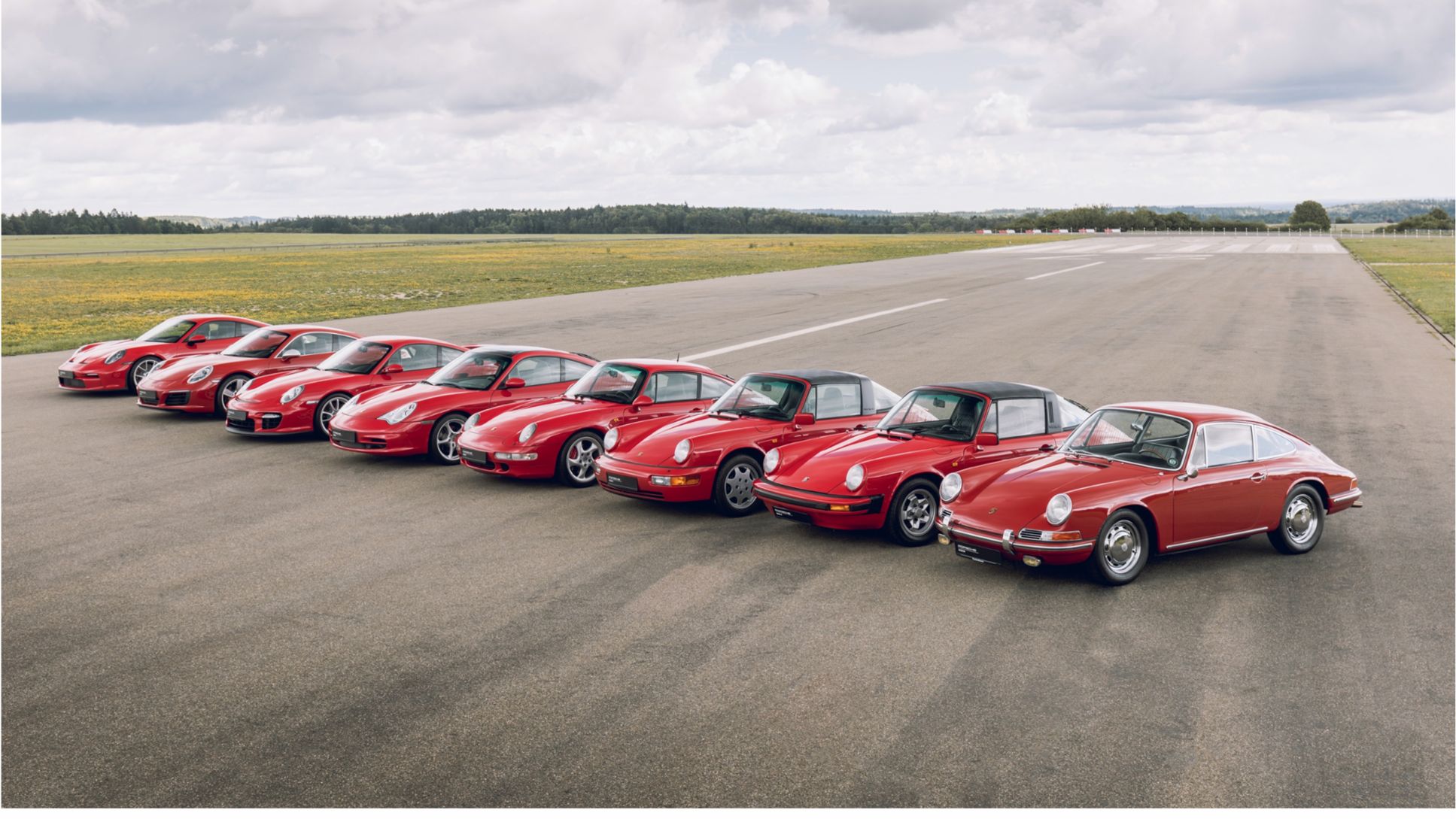Six decades of pure passion and driving enjoyment
The date was 12 September 1963. It was the debut, at the International Motor Show (IAA) in Frankfurt, of a car that would leave a lasting mark on the sports car world: Porsche presented the 901 as the successor to the popular 356. While at its debut the dynamic 2+2-seater had yet to bear the iconic 911 name, it would set the tone for the following 60 years. It would prove to be the technological, visual and emotional blueprint for one of the longest model lineages in the automotive world.
In keeping with Porsche’s leitmotif “driving in its most beautiful form”, Porsche engineers have continuously refined the legendary sports car, but always with the utmost care. They have optimised and improved it over eight vehicle generations (and counting) while always preserving its character and distinctive silhouette. The 911 combines sportiness with day-to-day usability, tradition with innovation, an air of exclusivity with social acceptance, and form with functionality like no other model.
The first-generation Porsche 911 (1963-1973)
The original 911 offered what its predecessor still lacked: the first Porsche 911 featured two fold-down seats in the rear. It also had a large luggage compartment and a powerful boxer engine with six cylinders, all packed into a smooth, sleek and modern body. Porsche retained the proven rear-engined layout and air-cooled engine. Both technical solutions would become trademarks of the model line, and the rear-mounted engine remains today.
The six-cylinder engine in the first 911 initially generated 130 PS from 2.0 litres of displacement and reached a top speed of 210 km/h. Later, Porsche added further power levels with 110 PS, 140 PS and 160 PS models. In 1970, engineers increased the displacement from 2.2 to 2.4 litres, and even 2.7 litres in the aptly named top-of-the-range model, the 911 Carrera RS 2.7. In its most powerful incarnation to date, the Porsche 911 developed an impressive 210 PS. The 911 T, E and S variants were the first German vehicles to fulfil the strict emissions standards of the US’s Environmental Protection Agency (EPA). From 1967, the semi-automatic four-speed Sportomatic gearbox was offered as an alternative to the manual transmission.
Porsche initially offered the original 911 only as a coupé. This was followed in 1967 by the 911 Targa, a ‘safety-conscious’ cabriolet with a wide roll-over bar. In the course of its 10-year production period, the first 911 was equipped with a three-part safety steering system, internally vented disc brakes, mechanical fuel injection and a sealed body cavity to protect against rust. It was also the first production passenger vehicle to come with a rear spoiler to reduce lift.
G-Series: The second-generation Porsche 911 (1973-1989)
Porsche revised the 911 in 1973, but retained the silhouette and design. Production of the model referred to internally as the ‘G-Series’ began after the 1973 summer break, and the 911 became slightly longer and more comfortable. Its new plastic bumpers protected the body against parking damage, while automatic seat belts and integral seats protected the occupants. Porsche introduced a body with a wider rear in 1977, and a 911 Cabriolet without a roll-over bar in 1983. The 911 Targa remained part of the line-up. From 1988, the 911 Speedster rounded off the portfolio of body types.
Flat-six engines with 2.7 litres of displacement came standard in the G-Series from the base model up. The base model’s powertrain generated 150 PS. The technological highlight of the second 911 generation was the 911 Turbo, known internally as the 930. The first Porsche with an exhaust turbocharger initially developed 260 PS, with a further jump to 300 PS in 1977. The model line also featured innovations such as hot-dip galvanised sheet metal (from 1975) and digital engine electronics (1984).
964: The third-generation Porsche 911 (1989-1994)
Porsche fundamentally revamped the 911 in 1989. Almost 85 per cent of the model internally designated the 964 was newly developed, from the bullish-looking front end to the aerodynamically optimised rain gutters and the striking design of the car’s rear. Power steering, ABS, a more efficient heater, a central locking system and height-adjustable seats were now part of the equipment. A newly developed 3.6-litre flat-six developed 250 PS. The top-of-the-line 911 Turbo S made 381 PS. The available body styles remained the Coupé, Cabriolet, Targa and Speedster.
For the first time, the 911 also featured all-wheel drive. In the 911 Carrera 4, Porsche used a revised all-wheel-drive system adapted from the 959 super sports car. Porsche also introduced an automatically retractable rear spoiler as well as dual ignition and knock control. The 911 was offered for the first time with the fully automatic Tiptronic in 1989, followed by standard driver and passenger airbags in 1991. The 964 was the first series production vehicle with a metal catalytic converter as standard.
993: The fourth-generation Porsche 911 (1994-1998)
Porsche invested some 400 million Deutschmarks in the development of the new 911. Only the roof line was carried over directly from its predecessor, with designers meticulously adapting every other line on the car. The new model also stood out from its predecessor in terms of driving: a multi-link rear axle improved driving dynamics and comfort. The output of the flat-six engines ranged from 272 PS in the entry-level model to 450 PS in the 911 Turbo with the ‘works power kit 2’ option. For the first time, the lightweight and purist-focused Turbo-based 911 GT2 was included in the model range.
In the 993 generation, Porsche brought the OBD II exhaust control system, hollow-spoked aluminium wheels (in the 911 Turbo), twin turbos and the Varioram intake system with adjustable intake pipe length (from 1996) to series production. For the first time, the 911 Targa featured an electrically retractable glass roof. And for the last time, the engines in a Porsche 911 were air-cooled.
996: The fifth-generation Porsche 911 (1998-2005)
The reinvention of the 911. The 996 was longer, wider and lighter, and featured non-round headlights for the first time in a 911. The most important new feature, however, was the water-cooled engine. Stricter emission standards in connection with the introduction of the new four-valve cylinder heads required the temperature balance in the flat-six engines of the 911 to be regulated with water. This measure boosted the power in the entry-level model to 300 PS. The power spectrum ranged up to 462 PS in the top-of-the-line 911 GT2.
A special brake system made its debut in the fastest 911 of the 996 generation: the Porsche Ceramic Composite Brake (PCCB) came standard in the 911 GT2. The brake discs were extremely heat-resistant, significantly lighter than a steel brake disc, and were highly durable, with a service life of up to 300,000 km.
997: The sixth-generation Porsche 911 (2004-2012)
In the 997, Porsche returned to the classic round headlights. This 911 went back to its roots for a look that set it further apart from the Porsche Boxster. All engines were more powerful. They ranged from 325 PS in the 911 Carrera to 620 PS in the just-launched 911 GT2 RS. The new 911 GTS closed the gap between the 911 Carrera S and the 911 GT3. For the first time, a fast-shifting dual-clutch transmission was available in the Porsche 911.
Porsche also introduced Porsche Active Suspension Management (PASM) in the 997, developed a rack-and-pinion steering system with a variable steering ratio, and installed turbochargers with variable turbine geometry (VTG) in the 911 Turbo. It was the first series-production petrol engine to feature this technology. In addition, the 997 marked the debut of a valve-controlled exhaust system and a Sport mode that could be activated at the touch of a button.
991: The seventh-generation Porsche 911 (2011-2019)
Significantly longer wheelbase, a wider track and sophisticated technology: the 991 represented a major development step for Porsche. Thanks to its aluminium-steel construction, its longer and wider body weighed 80 kg less than its predecessor’s. And although the 911 was now noticeably sportier, it also offered more comfort and space than ever before. At the start of production, a 3.4-litre flat-six engine in the 911 Carrera developed 350 PS. From 2017, the top-of-the-line 911 GT2 RS delivered twice that power.
With the 2015 model improvements, Porsche switched the powertrains in the Carrera and GTS models from naturally aspirated to turbocharged engines. The new power units offered more power with lower emission values. Porsche also introduced the PDCC anti-roll stabilisation, rear-wheel steering, active aerodynamics and a water-injection system for the intercoolers in the 991. In 2013, the company celebrated a major model anniversary with the special edition Porsche 911 ‘50th Anniversary Edition’.
992: The eighth generation of the Porsche 911 (from 2019)
With the model change to the 992 generation, Porsche readied the 911 for a partially electric future: a newly designed eight-speed dual-clutch transmission left room for an electric motor in the bell housing. Meanwhile, improvements within the engine reduced harmful emissions from the flat-six powertrains. Their power figures, as of summer 2023, were 385 PS in the 911 Carrera and up to 650 PS in the 911 Turbo S.
Wet-road detection, Night Vision Assist and a drag reduction system are just a few of the innovations that made their debuts in the new 911. While the engines of the sports car have been continually modernised and improved, Porsche has never lost sight of its rear-view mirror: for the first time since 1984, there is an off-road-capable 911 in the ranks with the 911 Dakar. The 911 Sport Classic, meanwhile, tips its hat to the iconic rear spoiler of the 911 Carerra RS 2.7 of 1972. And with the 911 S/T, Porsche marks the 60th anniversary of the 911.

